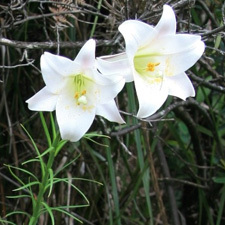 Formosa lily
Formosa lily
Common name: Formosa lily; Taiwan lily
Botanical name: Lilium formosanum
Management programme: Advisory
Originates from Taiwan. Introduced to New Zealand as an ornamental garden plant and naturalised by 1972.
Why is it a pest?
- Competes with native plants for space, especially a problem on dune ecosystems.
- Spreads quickly and easily as seed is wind dispersed and the bulbs spread vegetatively underground.
Where is it found?
- Generally found along roadsides and disturbed areas.
- Formosa lily is generally spread by people intentionally planting or dumping garden waste, gravity, wind, water, and vegetatively.
- Present throughout the Bay of Plenty region.
What does it look like?
- Attractive, large lily with a simple stem up to 1m tall.
- Stems root freely at ground level. Single stem rises directly from bulb.
- Many dark-green strap-like leaves up to about 13cm in length. Looks similar to the popular swan plant.
- Distinctive large, white scented, trumpet-like flowers, often tinged purple on the outside (January to March) followed by brown papery cylindrical seed capsules (February to April).
- Dies back each autumn.
- Usually three, but up to eight flowers each stem.
What are the rules?
Advisory
The Bay of Plenty Regional Council does not enforce the control of advisory species. It is landowner/ occupier responsibility to manage these pests. Council may provide advice on how to manage or control these species if required.
How do you get rid of it?
Recommended:
- Dig out scattered plants, ensuring bulb is removed
- Overall spray
CAUTION: When using any herbicide or pesticide, PLEASE READ THE LABEL THOROUGHLY to ensure that all instructions and directions for the purchase, use and storage of the product, are followed and adhered to.
Read more on pest control advice, information and regulations.
Images







